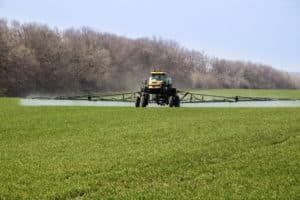From the water we drink to the air we breathe, the abundance of toxins in our environment is overwhelming. We all need to take the time to become more aware of how the things we consume affect us, and that is exactly the mission of National Poison Prevention Week. This is an opportunity to highlight the dangers toxins pose for people of all ages and allow for community involvement in poison prevention. Heightened awareness now may lead to better health and safety in the long run.
Toxins in the Water
Access to clean water is a basic human necessity but, unfortunately, is not always attainable. According to the Water Project, 783 million people do not have access to clean water. Although many agencies work diligently to rectify the issue, people from sub-Saharan Africa all the way to Flint, Michigan still struggle to find clean water. Certain water sources, like saltwater, are naturally inconsumable, but many viable freshwater sources are greatly affected by contamination. The EPA breaks these contaminants down into four categories: physical, chemical, biological and radiological.
According to a study by Yuhei Inamordi of the National Institute of Environmental Studies, water sources contaminated by physical pollutants such as soil, sediment and other organic material may change the color, odor and pH of water, but generally will not harm human health. However, the presence of trash and other human debris that does not naturally degrade or decompose in water can lead to health issues as they deposit chemicals into water sources.
Similarly, the result of organisms like bacteria, viruses, protozoans and parasites existing in a water supply, known as biological water contamination, can render water not only unusable, but dangerous. Animal waste and agricultural runoff, as well as on-site septic systems can cause bacteria to wash into drinking water supplies. Even more, standard operating procedures at nuclear facilities can still release radiation into the environment where radiological pollution can greatly affect human cell, tissue and DNA function. According to Riverkeeper, a New York-based clean water advocate, nuclear reactors routinely emit low levels of liquid radioactivity in the form of more than 100 different isotopes.
Evaluating Chemical Pollution of Water
Though each of the above scenarios is possible and well deserves attention and reflection, following recent water crises such as Flint, Michigan, the issue of chemical pollution is seemingly on everyone’s mind. Chemical water pollution can be very dangerous and lead to severe health problems. The presence of lead, asbestos, and pesticides have been directly linked to cancer and health defects in humans. Lead and asbestos have both been known to enter drinking water supplies through service pipes, where high water acidity levels and low mineral content causes them to corrode. Health implications stemming from lead exposure include reproductive problems, slowed growth and lower IQ in children, and development complications for pregnant women and their babies. Asbestos exposure has been linked linked exclusively to the aggressive cancer mesothelioma, one that results in a poor prognosis for many.
How to Remain Diligent
The CDC offers several tips to purify your water when a clean source is unavailable, including several techniques and processes:
- Boiling: Boiling water is a surefire way to kill biological contaminants
- Disinfectants: Can kill most disease-causing viruses and bacteria, but not as effective against resistant strains
- Filters: Many filters can remove disease-causing parasites, as well as physical contaminants found in tap water
While not all communities have access to clean water, there are many government and non-governmental organizations working extensively to provide clean water to those in need. Haws offers hygienic drinking fountains, electric water coolers, and Hydration By Haws™ hands-free activation bottle fillers. These water systems transform regular tap water into filtered drinking water by using a certified advanced filtration system and are lead-free by all known standards.
Although 71% of the Earth’s surface is covered by water, only one percent of the world’s supply is drinkable. Unfortunately, certain types of pollution cannot be remedied, but being aware of warnings and the water quality in your locality can help reduce your risk of waterborne illness. Make Poison Prevention Week from March 18-24 the catalyst you need to evaluate your drinking water and think about the safety of the water you consume daily.
Huge Fine for Pesticide Worker Safety Violations[via EHS Daily Advisor]
A global chemical and seed manufacturer was recently fined millions by the U.S. Environmental Protection Agency (EPA) for violations of several rules related to pesticides, including the Worker Protection Standard (WPS). This company ran afoul of its responsibilities when it comes to what the EPA considers the most dangerous pesticides: restricted use pesticides (RUPs). The recent amendments to the regulations for RUP applications that could affect over 1 million applicators nationwide.
 Syngenta Seeds, LLC, faces over $4.8 million in fines for pesticide violations at its crop research farm in Kekaha, Kauai, Hawaii.
Syngenta Seeds, LLC, faces over $4.8 million in fines for pesticide violations at its crop research farm in Kekaha, Kauai, Hawaii.
According to the EPA, 19 workers entered a Syngenta field that was recently sprayed with a restricted use organophosphate insecticide. Ten of these workers were taken to a nearby hospital for medical treatment. RUPs, which may only be used by licensed and certified pesticide applicators, may not be sold to the general public because of their high toxicity, potential for harm, and impact on the environment.
Here’s What Happened
The pesticide in question was Lorsban Advanced, a RUP registered with the EPA. It may only be used in accordance with the instructions on its label and the WPS. Under its use requirements, workers may not reenter treated areas without personal protective equipment (PPE) during the restricted entry interval (REI). The REI for Lorsban Advance is 24 hours.
The EPA alleges that Syngenta:
- Failed to notify its workers, both orally and with signs, to avoid fields recently treated with pesticides;
- Allowed or directed workers to enter the treated field before REI had passed and without proper PPE;
- Failed to provide water for routine and emergency eye flushing;
- Failed to provide adequate decontamination supplies on-site; and
- Failed to provide prompt transportation for emergency medical attention.
In all, there are 261 counts in EPA’s complaint. The proposed penalty is $18,750 per count for a total of almost $4.9 million.
Inspector Walking Around
An inspector from the Hawaii Department of Agriculture just happened to be at the Syngenta facility when the incident occurred, prompting an immediate investigation. She was there to investigate a prior complaint. Among other violations, she saw workers smoking cigarettes and drinking beverages before they had been decontaminated, so she immediately took photographs and documented what she observed. She also conducted follow-up investigations during which she took statements from workers. The Hawaii Department of Agriculture then formally referred the investigation of suspected WPS violations to the EPA.
Facts & Solutions: Lead in Drinking WaterAs recently reported in multiple media outlets, high levels of lead are tainting water systems across our country. Here are some data points and facts we have collected to help summarize the issues and challenges facilities and homes are facing:
- The EPA’s national testing “action level” for lead in water is 15 parts per billion.
- A national EPA analysis conducted between 2012 and 2015 showed 350 schools and day-care centers failed lead tests a total of 470 times. [1]
- Flint Water Study sampled 252 homes in Flint, Michigan and results showed that 40% of samples were over 5 parts per billion (ppb). Flint’s 90th’ile lead value is 25 ppb in that survey. [2]
- Newark, NJ collected 2,067 samples from school buildings between 2012 and 2015 with 12% above the EPA “action level.” With results ranging from 16 to 558 ppb.[3]
- The EPA estimates that about 90,000 public schools and half a million child-care facilities are not regulated under the Safe Drinking Water Act because they depend on water sources such as municipal utilities who are expected to test their own water.[4]

- EPA recommends anyone concerned with lead should only consume filtered or bottled water (washing hands and bathing with unfiltered water is ok). Filtered water is a safe option only if the filter is certified to remove lead and it is replaced regularly. [5]
- EPA recommends using an NSF-certified water filter to remove lead. [6]
With many factors influencing water safety levels, we wanted to highlight some of the safety features of our bottle fillers and their certifications for those looking for solutions.
- Brita® Hydration Stations® are certified to NSF International 53 to remove 99% percent of lead and 99.9% of cysts from tap water that has a lead concentration of 150 parts per billion. [7]
- Point-of-Use bottleless units are designed for smaller amounts of drinking water and offer a 1,500-gallon capacity certified Brita® professional filter.
- Wall unit bottle fillers are designed for larger consumption rates and offer a 2,500 gallon capacity certified Brita® professional filter.



